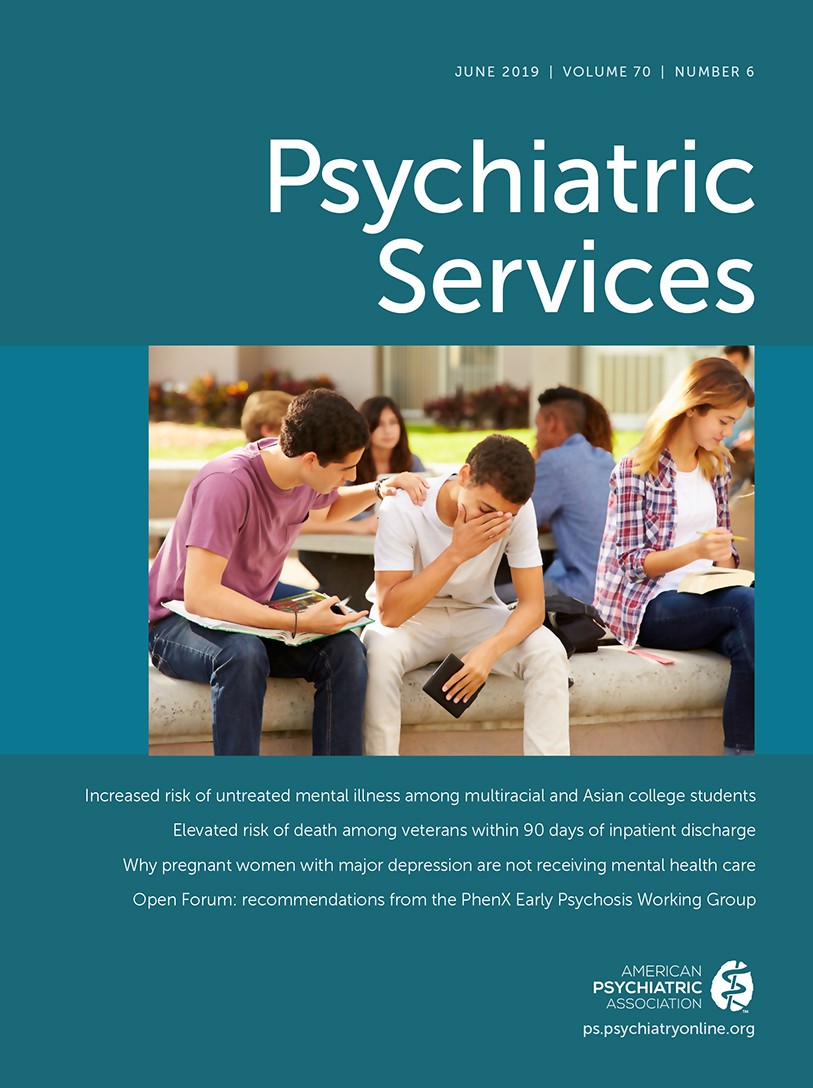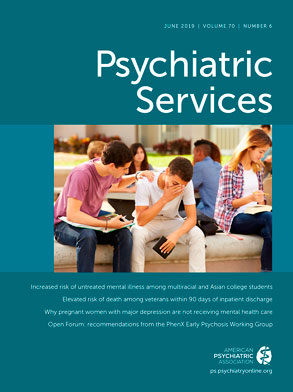Readers of this journal won’t be surprised to learn from Katz et al. (
1) in this issue that Veterans Health Administration (VHA) beneficiaries being discharged from U.S. Department of Veterans Affairs (VA) psychiatric inpatient care have disproportionately high mortality, especially in the 30–90 days after discharge. Psychiatric hospitalization is a marker of serious mental illness, which is known to be life threatening—directly via suicide and overdose, and indirectly via medical problems that are behaviorally and/or biologically linked to serious mental illness. Katz et al. report that their findings of elevated suicide after psychiatric discharge replicate findings from prior research in the VA and elsewhere. Their finding of elevated nonsuicide external-cause mortality, while new, is also not unexpected, especially because most such deaths result from accidental overdose, which is currently epidemic in the United States.
Even so, it is important to acknowledge the novelty of this work and the potential clinical and public health benefits that could follow from regularly monitoring patterns and correlates of mortality among individuals with serious mental illness across the U.S. health system. Such reporting is routine in other parts of U.S. health care, particularly for cancer, where oncologists enter all newly diagnosed patients into the national cancer registry system, which then tracks their health and health care for the rest of their lives (
2), and cardiology, where all heart surgery programs track a variety of patient outcomes, including 30-day postdischarge mortality (
3).
In contrast, nothing systematic has been done to monitor the survival of individuals in this country who have serious mental health problems—neither in relation to diagnosis, analogous to oncology, nor in relation to relevant psychiatric index events, analogous to cardiac surgery. Some such evidence has been reported for a specific geographic location, a subset of relevant patients, and/or a point in time, such as the Katz et al. study and the studies cited therein on suicide after discharge from psychiatric hospitalization, on mortality after incident psychosis diagnosis in a population cohort of young people (
4), and on suicide after certain types of outpatient health care visits in a set of integrated health systems (
5). However, nearly all such national findings have come from standalone research rather than from ongoing public health surveillance or clinical quality-monitoring programs. Moreover, there are key areas where I know of no available population-based information, perhaps most notably—given recent trends in suicide and overdose mortality—regarding survival after emergency department presentation for intentional self-harm, suicidal ideation, and accidental overdose.
Tracking patient outcomes can help improve health system performance, including in mental health care (
6). When institutions can compare their patient outcomes with those from peer institutions and/or over time, they can undertake initiatives to improve those outcomes, even if the comparators are deidentified or aggregated. If an organization’s performance is identifiable by payers or accreditors, those stakeholders can incentivize performance improvement, even if identifiable data are not released publicly. And if an organization’s outcomes are reported publicly, as occurs with most cardiac surgery programs, consumers can take comparative performance into account when they seek care.
An obvious prerequisite for tracking survival is to obtain mortality data on relevant health care populations. Broadly, there are three options: collection by registrars, and linkage to either state or national databases. The former is resource intensive, and reliability declines with longer follow-up; these factors presumably underlie why, for example, mortality of heart surgery patients is tracked for only 30 days postdischarge. Conditions for using state mortality data are set by each jurisdiction and vary widely; although some organizations link their populations to state mortality data (
5), most U.S. health systems and plans do not. Of the two searchable national mortality databases, the Social Security Administration’s full Death Master File (DMF), which contains date but not cause of death, has been restricted since 2011 to use by certain public benefit-paying agencies (
7), and the National Center for Health Statistics’ National Death Index (NDI;
https://www.cdc.gov/nchs/ndi), which contains date and cause, is available only for institutional review board–approved research and is expensive to use for large searches. In practice, the VA and the Centers for Medicare and Medicaid Services routinely link their beneficiaries to the DMF, and they have linked certain cohorts to the NDI. However, I am not aware of any major nongovernment U.S. health system or plan to have linked (generally or routinely) to either national database since the DMF became unavailable to them.
Lack of data linkage is not the only barrier to mortality tracking. Mental health care generally lags other fields of medicine with respect to tracking any patient outcomes (
6). Addressing this lag seems consistent with the principle of parity between mental and physical health care that has helped motivate other recent mental health reforms. Moreover, there is a special reason to track patient survival in relation to serious mental illness: with the obvious exception of suicide, mental disorders are almost never the official cause of death, so tracking mortality associated with serious mental illness requires tracking the mortality of people with serious mental illness.
Another argument invoked for not tracking mortality in psychiatric populations is because they are small, and mortality rare, in absolute terms. Here, too, it is appropriate to consider the principle of parity. For individuals receiving coronary artery bypass graft surgery, the most common cardiac surgical procedure, in-hospital mortality was 1.7% in 2016, and “operative” mortality (i.e., mortality during the hospitalization in which the surgery was performed, or in the 30 days after discharge) was 2.2% (
3). By comparison, Katz et al. report 1.6% external-cause (and 2.8% all-cause) mortality in the 30 days after psychiatric discharge for patients ages 18–64, and 2.3% external-cause mortality for patients age ≥65. There is no evidence that cardiac surgery programs are generally larger than psychiatric facilities. In any case, concerns about statistical variability could be addressed by aggregating or deidentifying organization-level outcome data, overall or for organizations below a certain size. Such approaches would also help address concerns about heterogeneity of patient case mix, to allow for the development of risk adjustment methods analogous to those used for cardiac surgery programs (
3).
The VA may already be building off the important initial work by Katz et al. to examine variation in mortality after psychiatric hospital discharge across VA regions or even facilities, and over time. Such efforts could also apply to a wider range of relevant index events, particularly incident suicidality and overdose. The same holds for Medicare and Medicaid, where serious mental illness–related mortality has been studied more than in any other part of the U.S. health system, but so far also not in any regular or recurrent way.
The federal Interagency Serious Mental Illness Coordinating Committee, charged under the 21st Century Cures Act to address the needs of people with serious mental illness, recently recommended “routine linking of [serious mental illness] and SED populations to mortality data, including tracking cause/manner of death, and analysis of survival rates after suicide attempts, emergency department presentation, and inpatient hospital discharge” (recommendation 1.8) (
8). As Katz et al. also suggest, such steps could help motivate and inform mental health quality improvement efforts. Mortality from cancer and heart disease have declined substantially while mortality associated with mental illness has not. What gets measured gets improved.

